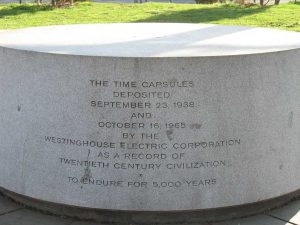By: Regine Vincent, Bicentennial Intern, Class of 2019, Chemistry, Bloomington

The purpose of this project is to generate a time capsule to celebrate IU’s bicentennial. The aim of the project is for the capsule to be buried in 2020 as part of the bicentennial celebration and to mirror the capsule that was buried somewhere on the IU Bloomington campus in the 1920’s to celebrate IU’s centennial.
The main goals that we wished to accomplish were to hopefully find more information on, as well as possibly the location of, the centennial time capsule. Also, most importantly, we hoped to begin developing a plan with steps on how to begin to constructing the capsule.
Research so far has mostly included searching for the location of the centennial capsule and gaining more knowledge about the seminary square campus as well as more about the centennial celebration of the university.
We have also focused our research on looking at national and state time capsules, as well as the presence of time capsules buried by other IU campuses. This research was conducted in order to gain more knowledge that will serve as helpful examples to aid in the construction of the bicentennial capsule.
My role in the project thus far has been to assist in the search for the centennial time capsule as well as to helping with the planning of the bicentennial capsule. In an attempt to develop a process for beginning to construct the capsule, my responsibilities included researching national time capsules.
In this research I found interesting information on famous time capsules such as the Crypt of Civilization[1] located on the Oglethorpe University campus in Atlanta, as well as the two Westinghouse[2] time capsules buried in New York State.



The research I conducted was able to provide the time capsule team with an ample amount of examples on the processes and procedures that go into building and burying a time capsule. Most of my research was conducted online, most especially through the use of online databases such as JSTOR and OneSearch@IU.

In an attempt to discover more about the time capsule construction process, I was given the task of contacting the campus historians for the IUPUI and IUPUC campuses and inquiring about the possibility of time capsules on such campuses. There was nothing found at IUPUC. However at IUPUI, the campus historian, Dr. Stephen E. Towne, was able to give a plethora of interesting information. Several time capsules have been buried at there.

My search for the centennial time capsule has lead me deeper into research about the history of IU Bloomington. In this part of the project I had to utilize the IU Archives to search for any documentation about the location of the centennial capsule.
In doing so, I was able to find about John W. Cravens, a man who served the university for years and wrote a great deal about the founding and creation of IU’s original seminary square campus.
Thus far a lot of information has been gained and progress made. However, there is yet more work to be done. Researching and planning is ongoing on how exactly to construct a time capsule. Currently a specific focus is on developing an intake plan in order to decide what type of items would go into the time capsule.
The intake process would include the participation of all IU students, faculty, alumni, and staff.
Also, part of the intake plan would incorporate an advisory board who will review the suggestions made and advise the bicentennial team on the best course of action.
Future project goals include working with the Glenn A. Black Laboratory, to discover the location of the centennial time capsule and to get approval for an excavation at seminary square which we believe is the most likely location for the centennial time capsule.
The most difficult part of the project was the research, especially deciding what to do and where to look when I came to dead ends. Also, learning to utilize new sources of research besides the internet, such as the IU Libraries and IU Archives was strange and new to me. However, learning to utilize such resources have greatly advanced my research ability.
I have learned a lot about IU and Indiana state history through this project and all of my research. In particular I have learned a lot about how IU began and a lot about what IU was like in the 1920s. From this research I learned how to use new equipment and programs such as the microfilms and Timeline JS.
What I am most proud of is that not only have I learned how to conduct better research, which will without a doubt help me in my college career, but I have also helped contribute to IU by being a part in planning the celebration of the university’s 200th year.
Works Cited
[1] Hudson, Paul S. “Crypt of Civilization.” New Georgia Encyclopedia. 16 January 2014. Web. 13 April 2017.
[2] Sterbenz, Christina. “An Incredibly Ambitious Time Capsule Was Sealed 75 Years Ago Today – Here’s What’s Inside.” Business Insider. April 30, 2014. Accessed April 17, 2017.http://www.businessinsider.com/westinghouse-time-capsule-2014-4.